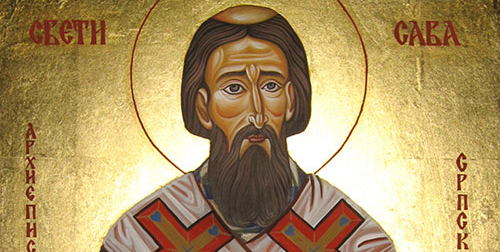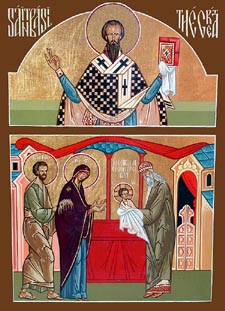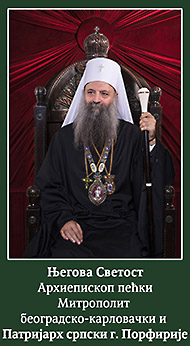Saint Sava I, First Archbishop of Serbia
 Saint Sava, First Archbishop of Serbia, in the world Rostislav (Rastko), was a son of the Serbian king Stephen Nemanya and Anna, daughter of the Byzantine Emperor Romanus. From his early years he fervently attended church services and had a special love for icons.
Saint Sava, First Archbishop of Serbia, in the world Rostislav (Rastko), was a son of the Serbian king Stephen Nemanya and Anna, daughter of the Byzantine Emperor Romanus. From his early years he fervently attended church services and had a special love for icons.
At seventeen years of age, Rostislav met a monk from Mount Athos, secretly left his father’s house and set off for the Saint Panteleimon monastery. (By divine Providence in 1169, the year of the saint’s birth, the ancient monastery of the Great Martyr and healer Panteleimon was given to Russian monks.)
The Holy Martyrs Ermil and Stratonik
Commemorated on January 13/26
The Holy Martyrs Ermil and Stratonik, by origin Slavs, lived at the beginning of the IV Century during the time of persecution against Christians by the emperor Licinius (307-324). They were friends. Saint Ermil served as deacon in the city of Singedonum (Belgrade). Condemned by Licinius to imprisonment, he was long and cruelly tortured for the Name of Christ, but he remained unyielding. Saint Stratonik was a superintendent of the prison and a secret Christian. Seeing the agonizing torments of his friend, he was not able to keep from weeping, and he revealed that he was a Christian. They subjected him also to torture. After the torturing, they put the martyrs into a net and threw them into the Danube/Dunai. On the third day, the bodies of the saints were discovered on the bank of the river by Christians and buried near Singedonum. Their venerable heads are located in the Church of Saint Sophia, where the Russian pilgrim Antonii saw them in the year 1200.
Saint Gregory, Bishop of Nyssa
 Saint Gregory, Bishop of Nyssa, was a younger brother of Saint Basil the Great (January 1). His birth and upbringing came at a time when the Arian disputes were at their height. Having received an excellent education, he was at one time a teacher of rhetoric. In the year 372, he was consecrated by Saint Basil the Great as bishop of the city of Nyssa in Cappadocia.
Saint Gregory, Bishop of Nyssa, was a younger brother of Saint Basil the Great (January 1). His birth and upbringing came at a time when the Arian disputes were at their height. Having received an excellent education, he was at one time a teacher of rhetoric. In the year 372, he was consecrated by Saint Basil the Great as bishop of the city of Nyssa in Cappadocia.
Saint Gregory was an ardent advocate for Orthodoxy, and he fought against the Arian heresy with his brother Saint Basil. Gregory was persecuted by the Arians, by whom he was falsely accused of improper use of church property, and thereby deprived of his See and sent to Ancyra.
Saint Seraphim's Life
August 1 and January 15 (July 19 and January 2 old calendar)
Saint Seraphim of Sarov was one of the greatest Russian ascetics and wonderworkers, with profound spiritual discernment. He was distinguished by a great humility. When being praised by all the world, he referred to himself as "the poor wretch Seraphim."
The Circumcision of our Lord and Savior Jesus Christ
 On the eighth day after His Nativity, our Lord Jesus Christ was circumcised in accordance with the Old Testament Law. All male infants underwent circumcision as a sign of God’s Covenant with the holy Forefather Abraham and his descendants [Genesis 17:10-14, Leviticus 12:3].
On the eighth day after His Nativity, our Lord Jesus Christ was circumcised in accordance with the Old Testament Law. All male infants underwent circumcision as a sign of God’s Covenant with the holy Forefather Abraham and his descendants [Genesis 17:10-14, Leviticus 12:3].
After this ritual, the Divine Infant was given the name Jesus, as the Archangel Gabriel declared on the day of the Annunciation to the Most Holy Theotokos [Luke 1:31-33, 2:21]. The Fathers of the Church explain that the Lord, the Creator of the Law, underwent circumcision in order to give people an example of how faithfully the divine ordinances ought to be fulfilled. The Lord was circumcised so that later no one would doubt that He had truly assumed human flesh, and that His Incarnation was not merely an illusion, as certain heretics had taught.
In the New Testament, the ritual of circumcision gave way to the Mystery of Baptism, which it prefigured [Colossians 2:11-12]. Accounts of the Feast of the Circumcision of the Lord continue in the Eastern Church right up through the fourth century. The Canon of the Feast was written by Saint Stephen of the Saint Sava Monastery.






